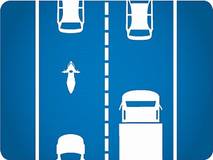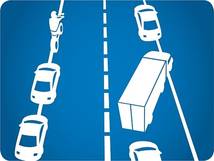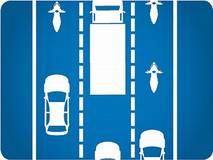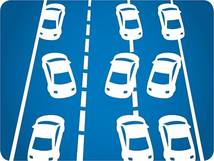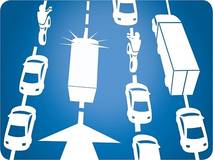Security
Germany
Phone number for emergency calls in Germany: 112
Polizeipräsidium Oberbayern Süd
Verkehrsmeldestelle Bayern (VMS BY)
Kaiserstrasse 32
83022 Rosenheim
Phone no.: 0049 (0)8031 200 1285 (24-hour service)
pp-obs.pp.vms@polizei.bayern.de
ADAC (Allgemeiner Deutscher Automobil-Club) emergency calls:
http://www.adac.de/mitgliedschaft/telefonnummern_notruf/default.aspx
- Mobile phone-fixed line network: 0 180 2 22 22 22
- Mobile phone: 22 22 22
- Phone no. in case of sickness or injury: +49 89 76 76 76
http://www.gdv-dl.de/services-notruf.html
0800 NOTFON D is the emergency mobile phone number of German motor vehicle insurers. It is a freephone number and is in operation round the clock every day of the year. 0800 NOTFON D (0800 668366 3) can be called by simply entering the corresponding characters on a mobile phone keyboard. It is not necessary to record a number – simply enter area code 0800 and the name NOTFON D0800 NOTFON D (0800 668366 3).
Italy
The A22 information service ensures the accurate and punctual distribution of real-time information concerning occurrences that could influence travel on the motorway, as well as proposals for alternative routes. The information is distributed via the following channels:
- Telephone: The A22 road user service centre (Centro Assistenza Utenza, CAU) can be contacted by calling freephone numbers (800 279940 in Italy, 00 800 22022022 from Germany, Austria and Holland)
- Variable text signals
- Radio bulletins (“Inforadio”) and videotext (“Televideo”)
- Website and WAP.
In the event of a medical emergency, breakdown or accident, road users can call the corresponding emergency services directly (rescue service = 118, fire brigade = 115, traffic police = 113) or contact the A22 service as follows:
Service numbers:
- CAU: 0461 980085 – 0461 212851
- Freephone: 800 279940
- Emergency phones are installed at intervals of approximately 1,500 metres along the emergency lane and can be used for calling personnel at the CAU service centre. These phones are also equipped with three buttons for calling the required service (rescue, breakdown, fire brigade).
In order to ensure that assistance can be provided quickly and effectively, road users have to provide the following information:
- Required type of assistance (traffic service, accident assistance, breakdown service, medical assistance, etc.)
- Travel direction and detailed description of location based on the following orientation aids:
- Distance indicator in kilometres (signs with a green background along the centre strip) and hundred-metre indicators in Roman numerals (white signs on the safety barriers along the centre strip)
- Signs indicating the names of viaducts and tunnels
- Signs with a brown background, identification number and green logo of the A22 which are displayed on flyovers in order to indicate the danger of rockfalls.
The maintenance and assistance services, as well as breakdown service, are primarily provided by the traffic service, which is in operation round the clock every day of the year. The duties of the respective crews encompass monitoring, control, swift intervention in the case of accidents, indication of disturbances and interruptions, direct assistance for motorway users in difficulty, as well as supporting the traffic police in order to ensure the safe and efficient operation of the motorway. The 84 personnel of the A22 traffic service are deployed in the 6 Safety Service Centres (Centro di servizio per la Sicurezza Autostradale, CSA) along the motorway. Each CSA also has additional personnel at its disposal who can be called on directly on site or at short notice (standby service) in order to support the traffic service personnel.
Breakdown service
On the A22, breakdown assistance is provided as follows:
- By ACI Global S.p.A. (phone no. 803116)
- By Europ Assistance VAI S.p.A. (phone no. 803803).
Thanks to a network of contractors, the provision of the following services is assured round the clock every day of the year:
- Rapid removal (recovery and towing) of vehicles that have been left stranded as the result of an accident, breakdown or other occurrence
- Jump starts, supply of fuel, on-site repairs that can be carried out using the tools and equipment carried by breakdown service vehicles.
Rescue service
All emergency calls can be made via freephone number 118 or handled by the CAU. It is essential to ensure that the questions asked by the personnel at the emergency response centre are answered precisely so that that they can obtain the necessary information for accurately assessing the seriousness and complexity of the problem and thus for triggering the most suitable form of assistance in which the resources they have at their disposal (ambulances, helicopters, etc.) can be deployed as efficiently as possible.
Italy
Safety
Staff of the nine radio information centres located throughout Italy and of the multimedia centre in Rom, which is manned 24 hours a day, collects the information transmitted by 2,140 webcams installed along the road network, road workers, traffic police patrols and its customers, and constantly updates this information. Traffic information can either be communicated directly by Autostrade per l’Italia or, in some instances, sent to other media (such as the public television channel RAI), which then sort the information and broadcast it.
Autostrade per l’Italia informs its customers throughout their journey, using variable message signs that provide information on accidents, road works, traffic jams, travel times and weather conditions. When traffic flows smoothly, other types of messages are displayed (safety tips, suggested routes, etc.). The number of variable message signs installed throughout the motorway network has been increasing steadily over the past few years, so as to provide drivers with the most up-to-date information.
Accident management
Autostrade per l’Italia and the traffic police coordinate action taken in the event of an accident. The traffic police intervenes first, assisting those involved and securing the scene of the accident. Autostrade per l’Italia makes every effort to ensure that its staff and rescue services arrive rapidly so that traffic flows can return to normal (for example by cleaning the road surface) and to use its communication means to inform customers. If the fire services have to intervene, management of the road depends on the security assessment made by these services.
Breakdown servics
The following numbers can be dialled in the event of a breakdown, defect or accident on the road network operated by Autostrade per l’Italia:
- ACI: 803-116
- Europ Assistance –VAI: 803-803
Autostrade per l’Italia authorizes service operators in each sector that meet regulatory requirements to offer breakdown services. Their permits require these operators to arrive at the scene of an accident of breakdown, if the vehicle is stopped on the road or in an emergency lane less than 3 metres wide, within 20 minutes in the case of light vehicles and 30 minutes in the case of heavy goods vehicles.
Tunnel safety
Transiting through tunnels safely
Having the best possible safety installations in road tunnels is one way of ensuring that tunnels are as safe as possible. By driving correctly, road users can make tunnels even safer. Below is a series of suggestions to ensure an accident-free journey. Also included are instructions on what to do in the event of an incident inside a tunnel.
Entering and driving through tunnels
- Switch on the headlights, take off your sunglasses und fold up the sun visor
- Listen to the traffic reports on the radio (in Austria, for example, the radio station Ö3 or one of the country-wide regional or private radio stations)
- If necessary, switch on your windscreen wipers (windscreens can quickly fog up in tunnels)
- Pay attention to traffic signals and information panels
- Pay attention to traffic lights and road markings
- Keep a safe distance
- Stick to the speed limit
- Stop only in the emergency bays, do not turn around in the tunnel.
If traffic comes to a standstill
- Do not turn around or reverse.
- Switch off the engine
- Listen to the traffic reports on the radio in Austria, for example, the station Ö3 or country-wide regional or private radio stations)
- Keep a safe distance from the vehicle in front
- Pay attention to traffic signals and information panels
- Pay attention to traffic signs and road markings
- If applicable, follow the instructions of the tunnel personnel.
If you have a breakdown or there is an accident in the tunnel
- Switch on your hazard lights
- Park your vehicle on the hard shoulder, in an emergency bay or along the right edge of the road
- Put on your high-visibility vest
- If after a breakdown or accident the vehicle is located outside an emergency bay it should be signalled using a hazard warning triangle
- Switch off the engine and leave the key in the ignition
- Use emergency call facilities (phone, “SOS“ or “fire“ buttons).
- DO NOT USE YOUR MOBILE PHONE
- Administer first aid
If there is a fire
- Switch on your hazard lights
- If your vehicle is on fire: if possible, leave your vehicle on the hard shoulder, in the emergency bay or on the right-hand edge of the road to allow the emergency services to pass
- Switch off the engine, leave the keys in the ignition and immediately leave your vehicle
- If possible, extinguish the fire while it is still small, using the fire extinguishers and hoses available in the tunnel
- Administer first aid
- Use emergency call facilities (telephone, the “SOS“ or “fire” buttons)
- DO NOT USE YOUR MOBILE PHONE
- Help others reach safety
- If there is a lot of smoke, immediately leave the tunnel using the escape routes and follow the instructions of the tunnel personnel
Safety notices
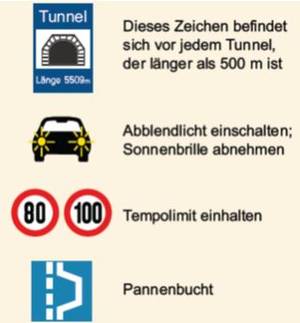 | 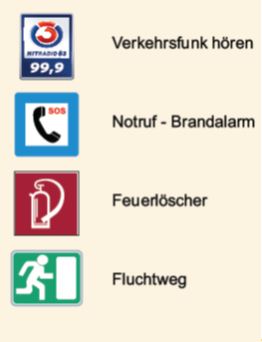 |
Left-hand column, from top to bottom
- This sign can be found at the entrance to any tunnel longer than 500 m
- Switch on dipped headlights; remove sunglasses
- Speed limit
- Emergency bay
Right-hand column, from top to bottom
- Listen to traffic reports on the radio
- Emergency call and fire alarm
- Fire extinguisher
- Escape route
Tunnel equipment
Emergency call facilities in the tunnel and near the tunnel mouth
Emergency call facilities are located in the tunnel in walk-in bays situated at intervals of approximately 125 m. Near the mouths of the tunnel the emergency call facilities are located in a closed booth. The emergency call bay or booth is lit from the inside and the door handle activates a contact when opened. A handset is available for making emergency calls. In addition, manual alarm buttons are provided to signal SOS or a fire.
Fire-fighting stations
Fire-fighting stations located every 125 to 150 metres include points for drawing fire-extinguishing water. The fire-fighting stations are equipped in consultation with the local fire departments. Every fire-fighting station is provided with a fire hydrant.
Escape and rescue routes
Escape and rescue routes are cross-cut shafts leading to the adjacent tunnel or to shafts leading from the tunnel interior to the outside. They are signposted in the tunnel. Signs distinguish between:
- Cross-cut shafts suitable for emergency vehicles, located at intervals of no more than 1,000 metres.
- Cross-cut shafts for use by pedestrians are located every 250 to 500 metres.
Stopping places/emergency bays
At most every 1,000 metres emergency bays are situated on the right-hand side, in the direction of travel, in which vehicles can be parked in the event of a breakdown or accident.
Ventilation systems
Under normal operating conditions ventilation systems inside tunnels ensure that pollutant concentrations do not exceed the lower limits.
A distinction is made between longitudinal and transverse ventilation systems. In longitudinally ventilated tunnels ventilation is by jet fan ventilators mounted on the tunnel ceiling. In tunnels with transverse ventilation, ventilation is by adjustable axial ventilators and exhaust-air louvers mounted in the intermediate ceiling. In the event of a fire, the louvers are used for local extraction.
Modern tunnel monitoring from high-tech control rooms
Tunnel installations are permanently monitored by specially trained operators. Control centres are equipped to monitor several tunnels at once. Automated systems such as video monitors, video image analysis and fire alarm system ensure a rapid response in the event of an incident.
Further information:
Rescue lanes
In Austria it is compulsory for all vehicles, such as cars, motor cycles, HGVs and coaches/buses, always to form a rescue lane when traffic is backed up or is moving very slowly. A rescue lane is defined as a space between the individual lanes of a motorway or expressway or other rapid road. This rule applies to all Austrian motorways and expressways or rapid roads with a central barrier, irrespective as to whether the carriageway consists of two, three or four lanes.
Caption: Traffic stopped? Form a rescue lane!
How to form a rescue lane:
All vehicles driving in the left lane have to move as far to the left of their lane as possible. All vehicles in the right-hand lane move as far to the right as necessary. In doing so vehicles should make use of the hard shoulder (emergency lane). If there are more than two lanes, the following rule applies: vehicles in the left lane move to the left, all the other vehicles to the right.
Captions:
- Forming a rescue lane on a two-lane road
- Forming a rescue lane on a road with more than two lanes
Further information:
http://rettungsgasse.com/web/guest/on-the-way/road-traffic-safety/emergency-corridor
www.asfinag.at/verkehrssicherheit/sicherheitslexikon

